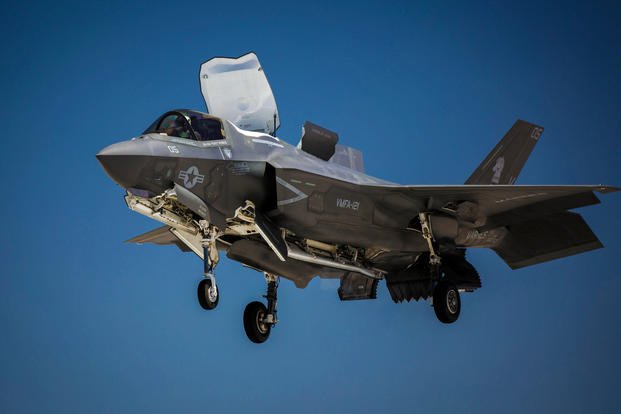An ammunition round that exploded following its discharge from a Marine Corps F-35B Joint Strike Fighter at Marine Corps Air Station Yuma, Arizona, earlier this month caused damage to the stealth fighter's fuselage, according to the service.
The F-35B, capable of short takeoff and vertical landings, was conducting a nighttime close air support mission on March 12 on the Yuma Range Complex when a PGU-32/U Semi-Armor Piercing High Explosive Incendiary-Tracer (SAPHEI-T) 25mm round exploded after leaving the fighter's cannon, Marine Corps spokesman Capt. Andrew Wood confirmed to Military.com on Tuesday.
The jet was attached to VMX-1, the Marines' Yuma-based test and evaluation squadron, Wood said.
Read Next: Guard Troops Ambushed in Texas, Held at Gunpoint While Transporting COVID-19 Vaccines
The aircraft landed safely, according to a Naval Safety Center report, which first noted the incident. "The mishap did not result in any injury to personnel, and an investigation of the incident is currently taking place," Wood said in an email.
The mishap was initially labeled Class A, the most severe classification, indicating damage of at least $2.5 million or the loss of an aircraft. Wood later said it was determined to be Class C, meaning the incident caused between $60,000 and $600,000 in damage.
It was not immediately clear if the round was fired deliberately. Citing the ongoing investigation, Wood did not provide further details.
The F-35 uses a GAU-22 Gatling gun. The GAU-22 is mounted in an external gun pod under the jet's fuselage on the Marines' F-35B and Navy's C-variant. The Air Force's A-variant carries the gun internally.
The Navy began evaluating its existing PGU-32 semi-armor piercing high explosive incendiary ammunition for the F-35B and F-35C in 2013. Live-fire testing from the gun pod began in 2016, according to The Drive.
In 2019, Marines in the Pacific carried out the first-ever at-sea F-35B "hot reloads" there, allowing the aircraft to drop back-to-back, 1,000-pound bombs on a target in the middle of the Solomon Sea.
Marines from the amphibious assault ship Wasp brought with them the "killer tomato," a big red inflatable target that floated off the coast of Papua New Guinea. The Joint Strike Fighter jets left the ship armed with the 1,000-pound GBU-32 Joint Direct Attack Munition and a 500-pound GBU-12 Paveway II laser-guided bomb.
During the same tests -- which marked the first-ever shipboard hot reloads in the Indo-Pacific region -- Marines also tested the SAPHEI-T 25mm round, according to a release.
With a capacity of 220 rounds, the 25mm gun pod can fire at a rate of up to 3,300 rounds per minute.
Editor's Note: This story has been updated to reflect the change to mishap classification.
-- Gina Harkins contributed to this report.
-- Oriana Pawlyk can be reached at oriana.pawlyk@military.com. Follow her on Twitter at @Oriana0214.
Related: Air Force Cuts Back F-35 Demo Performances Due to Engine Shortage












